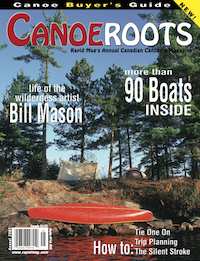Not having raced that hull for years, I wondered about the choice. The Jensen is a tad slower than the new Killing design I usually paddled. But it was also virtually identical to the hull used by the competitor next to me on the line, the year’s rookie in our master’s class. He was a lot younger, probably stronger … but maybe not faster. I wanted to race him on even terms.
I like Jensens. It is satisfying to paddle a classic modern hull, designed by the man who invented the category. Years ago, I moved the thwart back on mine to mount a seat amidships. I riv- eted in some aluminum angle for foot braces and, voila, my first solo canoe.
There were twelve hulls at the start. I aligned my bow with the first turning marker about one kilometre out. Good paddlers on either side, we kept our distance, feathering and bracing to hold our positions in the seconds counting down to the start.
THE AFTERGLOW OF TECHNICAL ADVANCES
I paddle in two of the most beautiful places in the world … in the waters beneath the mountains up Indian Arm just east of Vancouver, British Columbia and, once summer comes, in the islands on the east shore of Georgian Bay, Ontario.
I also paddle in the afterglow of huge technical advances in canoeing. Long, skinny, low profile canoes with straight keel lines to track like arrows and made of tough, light materials …. with adjustable seats and foot braces mounted amidships for soloing as well as in the stern and bow… vastly more efficient bent shaft paddles …. and the sit and switch technique, much more speed with much less effort.
FINDING THE PERFECT STROKE
Early each season, it feels like I have lead in my arms and sedative in my veins. I fight the paddle. I have to fool with my seat and foot brace to get the hull properly trimmed again. I have to move my torso around until it settles into the angle that will be comfortable for the rest of the season.
My stroke was laboured, … come on stroke, where are you? Just because I have spent a winter skiing doesn’t mean I have abandoned you forever. Repeat. Persevere through clumsiness until muscle memory kicks in and suddenly it is back.
As the season builds, I move constantly between the nature around me and an interior dialogue, watching my own technique, observing what works, what is getting better and what is not. Every hour or so, I pause and drink some water, eat something, look up at the mountains to the snow which stays well into the season. Later, when I am east, I float deep in the lees of the Georgian Bay archi- pelago, watching the charcoal, white necklaced loons who live in this bay as they raise the next generation just like I am doing with my children.
Eugene Jensen spends his life trying to build the perfect canoe. I spend a lot of mine trying to find the perfect stroke.
The perfect stroke—that elusive moment when you are in the perfect trim in the perfect canoe, when your hours of meditative paddling now allow you to divide a 1.2 second stroke into a hun- dred intervals and know exactly what you have to do in each one to be able to deliver maximum power in the instant when physics and geometry can deliver maximum efficiency—and you are suddenly in that moment, turning on the afterburner in a final shot of accelerating effort. You have made the canoe go as fast as it can. And then the canoe takes over, holding onto the speed you have given it in a long glide, a victory of inertia over friction thanks to the great designer who thought out your hull—and it waits for you to do it again.
The search is the reward. I have paddled the same routes all my life and they continue to give me something fresh each time out. A still, early summer rain shining the rocks and bringing out their colour as the lichen swells and softens, later, the first cardinal flow- ers telling me the summer is ending, crimson strokes painted along the ends of tough, thin green stalks late in the season. The search reintroduces me to my rhythms and gives the partnership of two good paddlers, the quiet pieces of shore on which you rest, the perfect union of form and function in those quick and beautiful hulls.
STRENGTH VS TECHNIQUE
If I had lost the race, the winner would have paddled well. I didn’t lose. I was ahead from the start and increased my lead the whole race. Two kilometres later, I finished fifty yards in front. The new guy is second. Two hours later, my brother and I won the doubles race in the same hull. He is all strength, I am all technique. We had the canoe humming early and we left good wake the whole race.
The new guy beat me in the sprints a week later. I was quicker off the line but he gained speed and I couldn’t hold mine. He beat me by almost a length. He and his partner did it again in the pairs. His sprint technique was better. Next year mine will be too … and I look forward to it.
Ted Cape is a 51 year old paddler for whom the sport was reborn when he discovered the modern canoes designed by pioneers such as Eugene Jensen and their successors. Over the years, he has accumulated 6 of these canoes. For him paddling has become athletic as well as aesthetic and for this he thanks the designers whose creativity, thoughtfulness and willingness to depart from tradition have produced these beautiful hulls.



